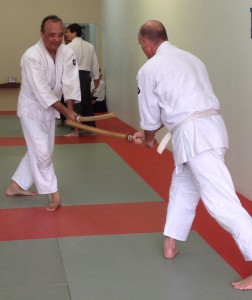By Michael Márquez, Ventura Aikikai

Life and death. When thinking recently about what to write for this essay, this is the first thing that came to mind.
Certainly, I also considered the several years of training I have experienced: the effort, time, sweat, injuries, frustration and joy. I recalled the support of my family, my wife and two daughters, and their understanding of my evenings away from home training, my Saturday mornings at the dojo, my attendance at Summer Camps and seminars. Memories of arriving home late in the evening as my two daughters are getting ready for bed, spending a few moments with them as they smile, running to me as I walk through the door, sleep heavy in their eyes, and listening to them telling me about their day.
My wife asking me about my training after the girls are in bed, and listening to me as I try to explain the joy of having done iriminage well after struggling with proper entry, or finally taking a decent breakfall for kotegaeshi. My fellow Aikido practitioners, who patiently worked with me each class to help me find my way to understand, improve, and express Aikido to the best of my ability. I also think about my senseis. Their dedication to Aikido: its practice, development and dissemination.
In essence, I believe I’m describing a context for my arrival at this point in my training. The effort and responsibility for my training is mine and it is important to understand the contexts in which I have arrived at this point. Without the quality of training offered by my senseis, the support and encouragement of my family, and the patience and good will of my fellow practitioners, I would not have come to this point in my training.
I came to Aikido in my middle age, my body and mind perhaps both stiff and a bit inflexible at this stage of my life. Aikido helped me learn to work with this and other “baggage” I brought to the dojo, until the five pillars Chiba Sensei described as crucial to the practice of Aikido (connection, liveliness, wholeness, openness, centeredness) began to take hold. Perhaps this is an example of what O-Sensei meant when he said “true victory is victory over oneself.” When I consider what O-Sensei may have given the world, it was the not just the beautiful martial way of Aikido we practice on the mat, it is what we take beyond the dojo. It is how we use the principles of Aikido outside of the dojo in our daily lives, and someday, as we face death. For me this includes how I “move” through my life, how I connect with each person with whom I interact: family, friends, people at work, and even strangers who I only meet once. Entering, a crucial part of our execution of technique, is also how we enter each situation life presents us. I believe this to mean entering into interactions with other people, but can also mean entering an environment and phases of our lives.
For example, since I began training, I’ve gotten married, had children, and started a career after graduate training. These experiences have all presented opportunities to express the five pillars of Aikido in my daily life. I have done so inconsistently, yet I think about doing so with increasing frequency. I think this is what O-Sensei meant when I’ve heard the term “big Aikido” used.
It is difficult to put into words, exactly, what Aikido has meant to me. Did I choose to begin training in Aikido, or did Aikido choose me? From the memory of first observing Aikido at Ventura Aikikai (then called The Moving Centre), during a seminar at which I watched guest instructor Darrell Bluhm Sensei move so powerfully, clearly, and directly. What captivated me was his smile as he joyously instructed the class. I remember thinking that this is what I wanted. I was not quite sure what “it” was all about but I wanted it. An intuitive pull to attain the ability to move, defend myself, and understand what I was observing. I had never trained in a martial art before nor observed a class of martial artists training. What I came to experience over time was a community of individuals who care passionately about their training, each other, and the Aikido we try to understand and embody in our training.
I believe Aikido also has lessons for how to approach death and the leaving of this world. How do we approach this inevitable stage of life using the principles of Aikido? One aspect of Aikido’s development was how one faced the possibility of death in the context of battle or when confronted by an attack. How do we work with our thoughts and emotions in these situations? Most of us will not have to face battle or being attacked. However, I believe our training and the principles of Aikido offer guidance at the time of our passing, as well as during our lives. To what degree can we enter our passing in a way that is whole, open, connected, lively and centered? Perhaps this will be difficult, perhaps not. It is my hope that I will be able to use these principles well when my time comes.
Life and death. Aikido. The training continues to inspire me to improve in the execution of techniques as nage, and in the receiving of techniques as uke. Training also inspires me to grow as a human being, to be in life what O sensei said about the purpose of Aikido: to bring out the best in people. In the end, there is only one thing left to say: Domo arigato gozaimashita!
Michael Marquez is a psychologist who works at a residential treatment facility for abused and neglected children. This essay was written in preparation for his shodan test.
